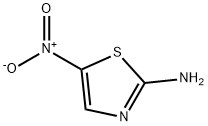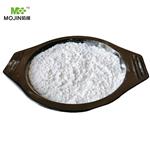Uses
Niltazoxanide USP Related Compound A 2-Amino-5-nitrothiazole.
Chemical Properties
greenish yellow, to orange or brown powder
Uses
2-Amino-5-nitrothiazole was used as diazo component in the synthesis of monoazo disperse dyes. It was used as matrix during matrix-assisted laser desorption/ionization time-of-flight mass spectrometric study of oligonucleotide and protein.
Definition
ChEBI: 2-Amino-5-nitrothiazole is a member of thiazoles and a C-nitro compound.
Production Methods
Early production of 2-Amino-5-nitrothiazole was
based on nitration of 2-acetylaminothiazole
and careful hydrolysis. Direct nitration of
2-aminothiazole gives a cleaner product and is
best achieved by adding 2-aminothiazole nitrate [57530-25-3] to concentrated sulfuric acid
at 0 – 10 ℃. This process and the nitration of o-anisidine are the only large-scale
processes based on rearrangement of an amine
nitrate, and both are potentially hazardous due
to the possibility of runaway exothermic reactions.
General Description
Greenish-yellow to orange-yellow fluffy powder or a brown chunky powder. Slightly bitter taste. Used as a veterinary medicine.
Air & Water Reactions
Insoluble in water.
Reactivity Profile
2-Amino-5-nitrothiazole may be sensitive to light. Incompatible with nitric acid and sulfuric acid. Also incompatible with strong oxidizing agents, strong acids, acid chlorides and acid anhydrides. A preparative hazard .
Fire Hazard
Flash point data for 2-Amino-5-nitrothiazole are not available. 2-Amino-5-nitrothiazole is probably combustible.
Safety Profile
Poison by intraperitoneal route. Experimental reproductive effects. Questionable carcinogen with experimental carcinogenic, tumorigenic, and neoplastigenic data. Mutation data reported. When heated to decomposition it emits very toxic fumes of NOx and SO,. Incompatible with HNO3 and H2SO4. An antiprotozoal agent.
Potential Exposure
2-Amino-5-nitrothiazole is a synthetic veterinary antiprotozoal agent used since 1950 to treat farm fowl and pigeons. It is also used as an intermediate in manufacturing a group of dyes known as disperse azo dyes. It is not known to occur as a natural product. People may be exposed to 2-amino-5-nitrothiazole through contact with birds treated with the drug, releases from poultry farms, and occupational exposures in the dye industry.





